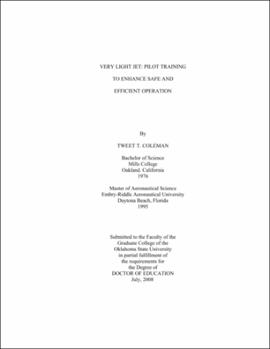| dc.contributor.advisor | Marks, Steven K. | |
| dc.contributor.author | Coleman, Tweet Theresa | |
| dc.date.accessioned | 2013-11-26T08:34:19Z | |
| dc.date.available | 2013-11-26T08:34:19Z | |
| dc.date.issued | 2008-07 | |
| dc.identifier.uri | https://hdl.handle.net/11244/7352 | |
| dc.description.abstract | Scope and Method of Study: The research was conducted to determine if the voluntary Federal Aviation Administration Industry Training Standards (FITS) and Controlled Flight into Terrain (CFIT) were included in the pilot's Very Light Jet (VLJ) training programs. In addition, some demographic variables like age, hours of flying experience and others, were looked at in relation to selected preference variables like preferred method of training, safety features and others, to see if there were any significant relationships. A purposive sampling of the population was obtained through personal visits to five aviation training sites where VLJ pilots were known to be in attendance. This data was collected using an on-site survey administered to a defined population of 25 pilots, each of whom was in or had already completed VLJ training. | |
| dc.description.abstract | Findings and Conclusions: The survey used included 19 closed-ended and two open ended questions, which provided sufficient information to adequately, address all six of the research questions. The results of the study indicated that of the 25 VLJ pilots who responded to the questionnaire, 22 (88%) reported that they were familiar with FITS, and 19 (76%) reported that FITS program was used during their VLJ training. The data revealed that 23 (92%) of the pilots were aware and had CFIT integrated into their training program. It was concluded that FITS and CFIT were included in the VLJ training program. The age range of the pilots surveyed was from 21 to over 60 years, with 16 (64%) over the age of 50. Overall there was no statistically significant relationship between the demographic variables and preference variables studied. Unlike other groups of professionals, these pilots appeared to think, act and share the same preferences regardless of any demographic variables included in the study. In general, these VLJ pilots, like other fliers, at any age or skill level appear to be willing to accept change if they think it will improve safety. | |
| dc.format | application/pdf | |
| dc.language | en_US | |
| dc.rights | Copyright is held by the author who has granted the Oklahoma State University Library the non-exclusive right to share this material in its institutional repository. Contact Digital Library Services at lib-dls@okstate.edu or 405-744-9161 for the permission policy on the use, reproduction or distribution of this material. | |
| dc.title | Very light jet: Pilot training to enhance safe and efficient operation | |
| dc.contributor.committeeMember | Kutz, Mary | |
| dc.contributor.committeeMember | Bliss, Timm | |
| dc.contributor.committeeMember | Key, James P. | |
| osu.filename | Coleman_okstate_0664D_2690 | |
| osu.accesstype | Open Access | |
| dc.type.genre | Dissertation | |
| dc.type.material | Text | |
| thesis.degree.discipline | Applied Educational Studies | |
| thesis.degree.grantor | Oklahoma State University | |
